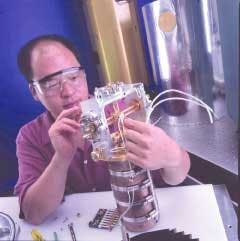Quantum cryptography will theoretically enable completely secure optical communications by taking advantage of the fact that anyone trying to eavesdrop on an encrypted code key will change the quantum state of the message-carrying photons and thus reveal the attempt to eavesdrop. At least two companies, ID Quantique (Geneva, Switzerland) and MagiQ Technologies (New York, NY), are developing commercial quantum-cryptography systems, and work is under way at numerous university and government laboratories to refine the technology and improve performance.
Single-photon sources and detectors are two of the critical elements in a quantum-cryptography system. To communicate securely over distances greater than 100 km, these sources and detectors must operate in the telecommunications windows of optical fiber—near either 1310 or 1550 nm. However, the systems currently under development are generally limited to the realm of visible light. Researchers at the National Institute of Standards and Technology (NIST; Boulder, CO), working with the Quantum Imaging Laboratory of Boston University (Boston, MA), have recently demonstrated a low-noise photon counter that can count photons from a weak 1310- or 1550-nm pulsed laser diode.1
The researchers have focused their efforts on detectors, with the understanding that the security of quantum cryptography systems can be compromised if the receiving device has high error rates. Typical detectors are limited by low sensitivity and high dark-count rates and cannot discriminate between the number and quantum state of incoming photons—information that is essential for directly measuring the multiphoton error rate of a single-photon source.
Using a microcalorimeter technology first developed for astronomical spectrophotometers, the researchers constructed a detection device based on a superconducting transition-edge sensor (TES). The TES is a tungsten film, fabricated on a silicon substrate, that absorbs a photon delivered by optical fiber and produces an electrical signal proportional to the resulting heat. The device measures 25 × 25 µm in size and 35 nm thick, with superconducting aluminum wires on the substrate.
The temperature rise comes as a result of a photon striking the film, which has been cooled to 120 mK—the transition temperature between normal conductivity and superconductivity. The TES detects the temperature rise as an increase in electrical resistance.
Researcher Sae Woo Nam says the intrinsic absorptivity of these tungsten films limits the optical efficiency of the TES to 20% to 30% across the near-UV to near-IR band, but can be greatly increased with the use of an antireflection coating. Furthermore, unlike the avalanche photodiodes or photomultiplier tubes typically used in this application, the TES can discriminate single photons because no amplification takes place. The device should find use as a means to quantitatively evaluate the security of single-photon sources and as a receiver in such systems.
REFERENCE
- Aaron J. Miller et al., Appl. Phys. Lett. 18 (July 2003).

